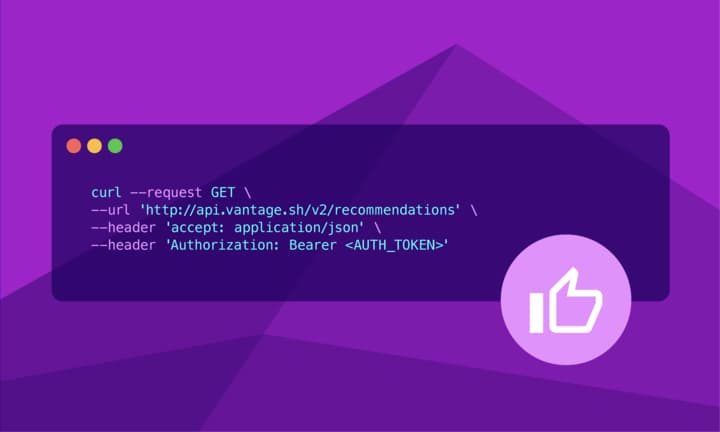Vantage Launches a Recommendations API Endpoint
Vantage launches a new recommendations API endpoint. Programmatically retrieve any financial, optimization, or waste reduction recommendations for your account.

Today, Vantage is announcing the launch of an additional API endpoint for querying recommendations. Customers who use the Vantage API can now filter and retrieve any financial, optimization, and waste reduction recommendations for their accounts.
Previously, Vantage customers could see recommendations in the UI; however, it was not possible to programmatically retrieve them or import them into another system. It was also not possible to filter these recommendations to specific providers, accounts, or recommendation types (e.g., optimization recommendations).
Now, recommendations can be programmatically retrieved via the /recommendations API endpoint. These recommendations can be filtered by provider, provider account, and recommendation type. For recommendations that are tied to specific resources, like Kubernetes rightsizing, customers can also retrieve the relevant resources through the /recommendations/<token>/resources endpoint. The response will include relevant metadata for corresponding resources, along with specific recommendation details for that resource.
To get started with this API endpoint, review the API docs. If you want to learn more about recommendations in general, see the product documentation.
Frequently Asked Questions
1. What is being announced today?
Vantage is announcing updates to the Vantage API. A new /recommendations endpoint is available.
2. Who is the customer?
The customer is anyone who wants to programmatically retrieve available recommendations from their Vantage account.
3. How much does this feature cost?
This endpoint is free to all users, including those in the free tier.
4. What is the format of the endpoint?
To fetch all recommendations, send a GET request to /recommendations. The following JSON is returned in a successful 200 response.
You can optionally pass in the following parameters with your request to further filter against your recommendations:
workspace_token: The token for the workspace to retrieve recommendations from.provider_account_id: Filter on the ID of the provider. For Azure, this would be the subscription ID.category: Filter by the category, such asaz_compute_reserved_instances,ec2_rightsizing_recommender, etc. A list of all categories is provided in the API documentation.provider: Filter by the provider, including AWS, Azure, Datadog, and Kubernetes.
See the API documentation for the full list of parameter values with examples.
5. What are the different types of recommendations?
- For AWS, Vantage provides recommendations related to categories like EC2 generational upgrades or suggestions for Reserved Instance or Savings Plan purchases. Vantage will also look for things like stranded resources, such as EBS volumes, IP addresses, and more, to ensure you've cleaned up everything you're not using. In addition, Vantage will identify EC2 rightsizing opportunities and provide specific reasons to rightsize, such as overprovisioned CPU.
- For Azure, Vantage will provide recommendations for compute reserved instances. These recommendations include suggestions for instances with on-demand usage that could be converted to reserved instances for better savings. Vantage will also provide recommendations for disks that have not been attached to a VM in the last 30 days.
- For Datadog, Vantage provides recommendations about making commitments for Datadog services where committed use discounts are offered. These recommendations are based on your actual usage of Datadog services to assist with making the right commitment.
- For Kubernetes, Vantage provides rightsizing recommendations for overprovisioned managed workloads. These rightsizing recommendations can help you identify affected resources.
See the documentation for details.
6. How do I authenticate with Vantage to use the API?
The Vantage API uses a Vantage API token for authentication. All API calls performed by the API are authenticated via your user token.
7. Where can I read the documentation?
Vantage provides multiple resources for getting started with the API:
- The Vantage API documentation site contains information about available API endpoints and provides a tool for running API calls directly on the site.
- The “FinOps as Code” repository contains tutorials and code samples for getting started with the Vantage API.
Sign up for a free trial.
Get started with tracking your cloud costs.

